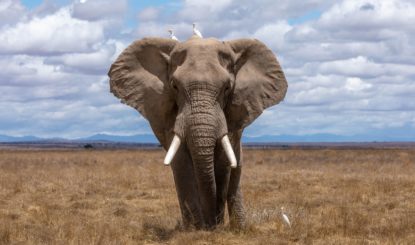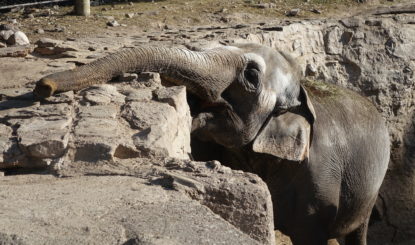The elephant Ceyla-Himali had by no means reached a ‘venerable’ age
On 12 August, Zurich Zoo announced that it had ‘had to euthanise’ the Asian elephant Ceyla-Himali because of her numerous health problems, including serious kidney problems, which the zoo attributed to her supposedly ‘elderly’ age. However, at 49, the elephant had not reached an advanced age: according to experts, many Asian elephants survive well into their 40s and frequently reach 60 to more than 70 years of age in the wild. It is only because of the conditions in captivity that the zoo considers the age of 49 to be ‘old’… According to the Franz Weber Foundation (FFW), Zurich should set an example by giving up breeding and, ultimately, keeping pachyderms.
Ceyla-Himali was born in 1975 in Sri Lanka, probably in a wild herd. She was taken in by an elephant ‘orphanage’ and arrived at Zurich Zoo in 1976, aged just one year. So for 48 years she had been living in the zoo’s enclosures, in unnatural conditions, on concrete, and had been used for breeding.
Zurich Zoo announced last Monday that it had ‘had to euthanise’ the 49-year-old elephant because of her numerous health problems, from which she had been suffering for a long time. In its announcement, the zoo claimed that Ceyla-Himali had reached an ‘elderly’ age.
According to various studies1, the average lifespan of elephants even in semi-liberty is 43 years, while that of elephants in zoos is just 19 years – this difference is explained only by the poor conditions in which they are kept, and the obesity and other health problems from which captive elephants often suffer, but also the high mortality rate of baby elephants in captivity. Obviously, these figures only concern average life expectancy, and not the age that can be considered ‘elderly’ for an elephant: in reality, a venerable age is between 60 and 70 for an Asian elephant – a 49-year-old female elephant in the jungles of Sri Lanka would be in the prime of life. In fact, wild elephants can give birth in the wild up to around 60 years of age.
Tomas Sciolla, FFW expert in biodiversity conservation and zoo conversion, believes that “the ethical implications of such a disparity in life expectancy are profound. It is morally unjustifiable to subject sentient beings to conditions that so radically reduce their natural life expectancy’. He goes on to say that it is ‘particularly depressing, in the case of the Zurich elephant, that her age of 49 can be considered “elderly” by the zoo, when in the wild Asian elephants can even reach 80 years of age’.
For Dr Keith Lindsay, an elephant biologist who is regularly consulted by FFW and who wrote a report on the situation of elephants in Swiss zoos in July 2023, Ceyla-Himali’s health problems and death are undoubtedly due to the conditions of captivity. “The recent untimely death of Ceyla-Himali at Zurich Zoo is undoubtedly entirely attributable to the inadequate conditions of her captivity. The lack of space to move around and feed freely on a varied range of species and plant parts inevitably leads to nutritional deficiencies, gastrointestinal imbalances and other problems with the internal organs. In addition, the total absence of decision-making opportunities and cognitive challenges in the search for food and use of space leads to boredom and lethargy, replacing the will to live with boredom. This physiological and psychological damage, combined with a lack of exercise and the resulting decline in muscle tone and cardiovascular function, results in an elephant in very poor health, the opposite of its wild counterpart’.
Vera Weber, President of FFW, once again notes the extent to which elephants have no place in captivity, particularly in Swiss zoos. ‘None of the Swiss zoos provide elephants with adequate conditions to satisfy their biological, psychological and social needs’, she explains. ‘Zoos urgently need to put an end to their elephant breeding programmes, and eventually stop keeping pachyderms – and Zurich Zoo could set an example and become a pioneer in this respect’.
1Sukumar R, Krishnamurthy V, Wemmer C & Rodden M (1997) Demography of captive Asian elephants (Elephas maximus) in southern India. Zoo Biology 16: 263–272 ; Mumby HS, Courtiol A, Mar KU & Lummaa V. (2013) Birth seasonality and calf mortality in a large population of Asian elephants. Ecology and Evolution, 3(11):3794-3803. doi:10.1002/ece3.746 ; de Silva S, Webber CE, Weerathunga US, Pushpakumara TV, Weerakoon DK, Wittemyer G. Demographic variables for wild Asian elephants using longitudinal observations. PLoS One. 2013 Dec 20;8(12):e82788. doi: 10.1371/journal.pone.0082788. PMID: 24376581; PMCID: PMC3869725.


